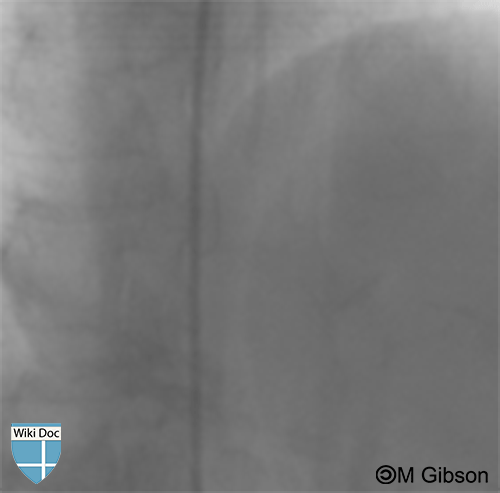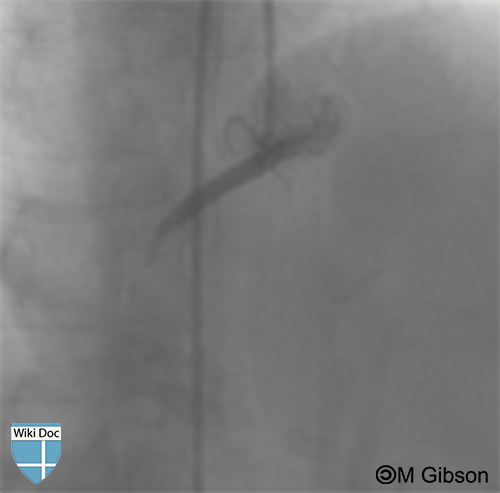No-reflow phenomenon coronary angiography
|
No-reflow phenomenon Microchapters |
|
Diagnosis |
|---|
|
Treatment |
|
Case Studies |
|
No-reflow phenomenon coronary angiography On the Web |
|
American Roentgen Ray Society Images of No-reflow phenomenon coronary angiography |
|
Risk calculators and risk factors for No-reflow phenomenon coronary angiography |
Editor-In-Chief: C. Michael Gibson, M.S., M.D. [1]; Jennifer Giuseffi, M.D.; David M. Leder, M.D.; Associate Editor(s)-in-Chief: Ayokunle Olubaniyi, M.B,B.S [2], Hardik Patel, M.D., Sapan Patel M.B.B.S
Overview
Coronary Angiography
Assessment of Epicardial Blood Flow
This involves the use of Thrombolysis in Myocardial Infarction (TIMI) blood flow grades (TFG) to evaluate epicardial coronary blood flow in acute coronary syndromes. This method measures the coronary artery clearance of the injected radiographic dye. It is graded from 0 to 3. Click here to view the grading system. Although TFG has been associated with clinical outcomes in the past,[1] its use has been limited by many confounding variables such as the location of infarct. For example, the majority of TFG 3 are located in the right coronary artery, while the majority of TFG 2 are observed in the left anterior descending artery.[1] A more accurate technique to evaluate epicardial coronary blood flow is by using the number of angiographic frames required for a dye to reach a specified distal segment in the coronary artery, this was referred to as the TIMI frame count (TFC) by Gibson et al in 1999. Although this method was associated with improved clinical outcomes, however, it is now understood that restoration of epicardial blood flow does not necessarily improve perfusion at the tissue level or microvascular perfusion.[2]
Shown above is an animated image and a static image depicting TIMI flow grade 0 in the RCA. Outlined in blue in the second
image is the flow of the dye which completely stops at the level of the stenosis. Outlined with a yellow dashed line is the pathway that the dye would have filled in case the stenosis was absent.
Assessment of Myocardial Perfusion
Perfusion of the myocardium has been shown to be an independent predictor of outcome.[3] This can be assessed directly by using myocardial blush grade (MBG), TIMI Myocardial Perfusion Grade (TMPG), coronary clearance frame count or digital subtraction angiography or can be assessed indirectly by using the corrected TIMI frame counts.
- TMPG focuses on the rate of clearance of the contrast opacity as well as the degree of intensity of the contrast opacity in the infarcted area when compared with the non-infarcted areas, while MBG focuses on the latter. Both of these methods are subjected, therefore, they are affected by observer bias.
- Coronary clearance frame count (CCFC) - This is a quantitative method designed to remove the observer bias associated with the prior methods. In order to calculate the CCFC, Frame 'O' represents the first frame in which the contrast medium is seen to be cleared from the ostium of the infarcted artery and the 'last frame' represents the point when the contrast begins to be cleared from the standardized distal landmark proposed by the TIMI Group. The difference between these two values of the frame counts is defined as the CCFC. The CCFC has been shown to correlate with both the TMPG and the MBG.[4]
- Digital subtraction angiography - This is a quantitative approach which estimates the rate of brightness and the rate of growth of the blush. At the peak of the contrast intensity, an area of the myocardium is sampled to determine the increase in brightness in Gy/secs and the circumference of the brightness is measured by a handheld planimeter. The number of frames required for the myocardium to reach peak brightness is converted into time by dividing the frame count by 30.
- Corrected TIMI frame count (CFTC) - This was designed to overcome the limitations of TFG as a more accurate method of estimating the coronary blood flow.
No-reflow Examples
Case 1
References
- ↑ 1.0 1.1 Gibson, CM.; Cannon, CP.; Daley, WL.; Dodge, JT.; Alexander, B.; Marble, SJ.; McCabe, CH.; Raymond, L.; Fortin, T. (1996). "TIMI frame count: a quantitative method of assessing coronary artery flow". Circulation. 93 (5): 879–88. PMID 8598078. Unknown parameter
|month=ignored (help) - ↑ Ito, H.; Tomooka, T.; Sakai, N.; Yu, H.; Higashino, Y.; Fujii, K.; Masuyama, T.; Kitabatake, A.; Minamino, T. (1992). "Lack of myocardial perfusion immediately after successful thrombolysis. A predictor of poor recovery of left ventricular function in anterior myocardial infarction". Circulation. 85 (5): 1699–705. PMID 1572028. Unknown parameter
|month=ignored (help) - ↑ Gibson, CM.; Cannon, CP.; Murphy, SA.; Marble, SJ.; Barron, HV.; Braunwald, E. (2002). "Relationship of the TIMI myocardial perfusion grades, flow grades, frame count, and percutaneous coronary intervention to long-term outcomes after thrombolytic administration in acute myocardial infarction". Circulation. 105 (16): 1909–13. PMID 11997276. Unknown parameter
|month=ignored (help) - ↑ Perez de Prado, A.; Fernández-Vázquez, F.; Cuellas-Ramón, JC.; Iglesias-Garriz, I. (2005). "Coronary clearance frame count: a new index of microvascular perfusion". J Thromb Thrombolysis. 19 (2): 97–100. doi:10.1007/s11239-005-1379-5. PMID 16052299. Unknown parameter
|month=ignored (help)

